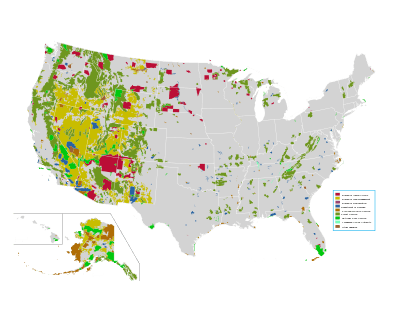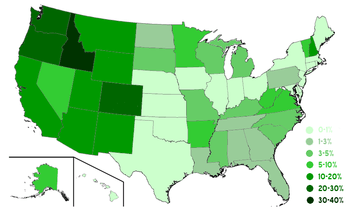Public land
In all modern states, some land is held by central or local governments. This is called public land. The system of tenure of public land, and the terminology used, varies between countries. The following examples illustrate some of the range.
Commonwealth countries
In several Commonwealth countries such as Australia, New Zealand and Canada, public lands are referred to as Crown lands. Recent proposals to sell Crown lands have been highly controversial.
France
In France, (French: domaine public) may be held by communes, départements, or the central State.
Portugal
In Portugal the land owned by the State, by the two autonomous regions (Azores and Madeira) and by the local governments (municipalities (Portuguese: municípios) and freguesias) can be of two types: public domain (Portuguese: domínio público) and private domain (Portuguese: domínio privado). The latter is owned like any private entity (and may be sold), while public domain land cannot be sold and it is expected to be used by the public (although it can be leased to private entities for up to 75 years in certain cases). Examples of public domain land are the margins of the sea and of the rivers, roads, streets, railways, ports, military areas, monuments. The State's private domain is managed by Direção-Geral do Tesouro e Finanças and the State's public domain is managed by various entities (state companies and state institutes, like Agência Portuguesa do Ambiente, I.P., Estradas de Portugal, E.P.E., Refer - Rede Ferroviária Portuguesa, E.P.E., APL - Administração do Porto de Lisboa, S.A., etc.).
Israel
West Bank
Israel on the West Bank are based in the Ottoman Empire law specifying land not worked for over ten years becomes 'state lands'. This became the base for deciding cases brought up by Arabs when certain Israeli settlements were created on presumed barren land (see Halamish).[1]
United States



In the United States governmental entities including cities, counties, states, and the federal government all manage land which are referred to as either public lands or the public domain.
The majority of public lands in the United States are held in trust for the American people by the federal government and managed by the Bureau of Land Management (BLM),. the United States National Park Service, Bureau of Reclamation, or the Fish and Wildlife Service under the Department of the Interior, or the United States Forest Service under the Department of Agriculture. Other federal agencies that manage public lands include the National Oceanic and Atmospheric Administration and the United States Department of Defense, which includes the U.S. Army Corps of Engineers.[4]
In general, Congress must legislate the creation of new public lands, such as national parks; however, under the 1906 Antiquities Act, the President may designate new national monuments without congressional authorization.
Each western state also received federal "public land" as trust lands designated for specific beneficiaries, which the States are to manage as a condition to acceptance into the union. Those trust lands cannot any longer be considered public lands as allowing any benefits to the "public" would be in breach of loyalty to the specific beneficiaries. The trust lands (two sections, or about 1,280 acres (5.2 km2) per township) are usually managed extractively (grazing or mining), to provide revenue for public schools. All states have some lands under state management, such as state parks, state wildlife management areas, and state forests.
Wilderness is a special designation for public lands which have been completely undeveloped. The concept of wilderness areas was legislatively defined by the 1964 Wilderness Act. Wilderness areas can be managed by any of the above Federal agencies, and some parks and refuges are almost entirely designated wilderness. A wilderness study area is a tract of land that has wilderness characteristics, and is managed as wilderness, but has not received a wilderness designation from Congress.
Typically each parcel is governed by its own set of laws and rules that explain the purpose for which the land was acquired, and how the land may be used.
Recreation on U.S. public lands
Most state- and federally managed public lands are open for recreational use. Recreation opportunities depend on the managing agency, and run the gamut from the less restrictive, undeveloped wide open spaces of BLM lands to the highly developed and controlled national and state parks. Wildlife refuges and state wildlife management areas, managed primarily to improve habitat, are generally open to wildlife watching, hiking, and hunting, except for closures to protect mating and nesting, or to reduce stress on wintering animals. National forests generally have a mix of maintained trails and roads, wilderness and undeveloped portions, and developed picnic and camping areas.
In an attempt to present a balanced view of the history and uses of America's public lands, two teams trekked the US, from the Canadian and Mexican borders, in a project known as American Frontiers: A Public Lands Journey.
Grazing on U.S. public lands
Historically in the western United States, most public land is leased for grazing by cattle or sheep. This includes vast tracts of National Forest and BLM land, as well as land on Wildlife Refuges. National Parks are the exception. This use became controversial in the late 20th century as it was examined by environmentalists.[5]
See also
- Acquired lands
- Federal enclave
- National Public Lands Day (in the US)
- Public domain
- State ownership
- United States territorial acquisitions
Footnotes
- ↑ Hoberman, Haggai (2008). Keneged Kol HaSikuim [Against All Odds] (in Hebrew) (1st ed.). Sifriat Netzarim. p. 169.
- ↑ Western States Data Public Land Acreage
- ↑ http://www.fs.fed.us/land/staff/lar/2007/TABLE_4.htm
- ↑ Federal Land Ownership: Overview and Data Congressional Research Service
- ↑ Pages 14-73, "The Public Lands Debate", Sharman Apt Russell, Kill the Cowboy: A Battle of Mythology in the New West, Addison-Wesley (May, 1993), hardcover, 218 pages, ISBN 0-201-58123-X
Further reading
- Nancy Ferguson, Sacred Cows at the Public Trough, Maverick Publications (December, 1983), trade paperback, ISBN 0-89288-091-0
- Impediments to Public Recreation on Public Lands: Oversight Hearing before the Subcommittee on Public Lands and Environmental Regulation of the Committee on Natural Resources, U.S. House of Representatives, One Hundred Thirteenth Congress, First Session, Tuesday, May 7, 2013
External links
- Public Lands Information Center: state and federal lands in the Western U.S.
- Recreation on Federal Lands: United States/ nationwide
- Public Land / Water Access Assoc.: Montana/ United States
- Our Public Lands: Western States/ United States